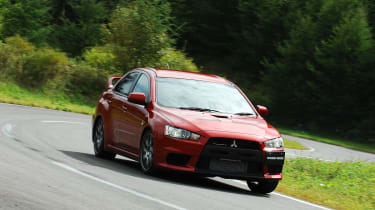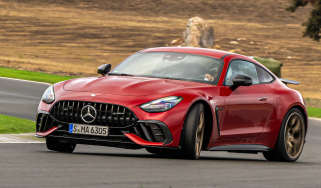Mitsubishi Evo v Subaru Impreza - Mitsubishi Evo X: Mitsubishi Evo X
Richard Meaden drives the Evo X and finds it very good indeed
We’ve grown-up together, the Evo and me. From pounding around the virtual twists and turns of Gran Turismo’s Trial Mountain to terrorising the Cotswolds riding shotgun with Richard Burns in his Evo III road car, the Mitsubishi Lancer Evolution has been an ever-present part of my motoring life.
Fittingly, the dummy issue of evo, used as a presentation tool before the launch of the real thing, also featured an Evo – a yellow Evo V – and in the nine years since then we’ve featured just about every subsequent Evo model.
The very first Lancer Evolution was introduced back in 1992. True to its name, the breed has evolved gradually ever since. At the height of its rallying powers the pace of development was such that we were treated to a fresher, faster Evo almost every year. This relentless succession of tweaked and honed versions slowed as the WRC effort was wound-down, but the introduction of an all-new Lancer base model has given Mitsubishi the perfect opportunity to to revitalise its iconic all-wheel-drive hero.
Diehards needn’t worry, for there’s also a five-speed manual transmission Evo X. But didn’t the IX have a six-speed ’box? Yes, it did, but Mitsubishi justifies this apparent backward step with the fact that the five-speed gearbox was always the preferred choice for rallying, plus it’s lighter than the six-speed item found in the Evo VIII and IX. Will it detract from the driving experience? We’ll find out soon enough.
More reviews
Group tests
- Alpine A290 v Alpine A110 – how much DNA do they really share?
- Ariel Atom 4R v Caterham Seven ‘evo25’: power-to-weight heroes go head-to-head
- Caterham Super Seven 600 v Super Seven 2000
- Levante v T1
- Corvette Stingray v Porsche Cayman GTS v Audi R8 RWD
- Great Ferrari hypercars driven: 288 GTO, F40, F50 and Enzo head-to-head
- Hardcore Ferrari V8 specials go head-to-head
- Lamborghini Aventador Ultimae v Lamborghini Countach
- Lotus Emira v Morgan Plus Four – four-cylinder Brits go head-to-head
- Toyota GR86 v BBR Mazda MX-5: supercharged drop-top battles sports coupe
In-depth reviews
- Abarth 600e 2025 review – Italy gives the Alpine A290 something to worry about
- Alpine A110 review – distinctive, lightweight and unforgettable to drive
- Audi R8 (2015 - 2024) review – the ultimate soft-focus supercar
- Bentley Continental R Mulliner: review, history and specs
- BMW 5-series review – is this still Munich’s anchor model?
- BMW 1-series review – Munich’s Audi A3 rival gains focus
Long term tests
- Abarth 695C Turismo Fast Fleet test – 10,000 miles in the Italian hot hatch
- Alfa Romeo Giulia Veloce Fast Fleet test – 7000 miles in the sharp Italian saloon
- Alpina B10: end of term report
- Alpina B10
- Ford Mustang GT
- Ford Mustang GT
- Ford Mustang GT
- Land Rover Defender 110 Fast Fleet test – 9000 miles in the go-anywhere SUV
- Maserati Ghibli Trofeo Fast Fleet test – 4000 miles in the Ferrari-powered saloon
- Mitsubishi Evo MR 340
Review
- New Aston Martin DBS 770 Ultimate review – 759bhp super-GT driven
- New Bentley Batur 2023 review – can it possibly be worth £1.65m?
- 2023 Chevrolet Corvette C8 Z06 review – the American 911 GT3?
- Kia EV6 GT-Line S prototype review – the EV that shows how it’s done
- BBR Supercharged Mazda MX-5 (ND) 2023 review – tuned 250bhp roadster driven
- MG4 Trophy 2023 review
Reviews
- Abarth 695 75 Anniversario edition 2024 review – a fitting send-off for Abarth’s hot supermini?
- Abarth 500e 2023 review
- AC Cobra 378 Superblower MkIV 2021 review – another V8 Cobra, but with a GM heart this time
- Acura Integra Type S 2024 review – a Honda Civic Type R with added restraint
- Alfa Romeo Giulia 2025 review – get one while you still can
- Alfa Romeo SZ: history, review and specs of an icon
- Alfa Romeo 1750 TBi
- Alpina B3 GT Touring 2025 review – a 190mph alternative to the BMW M3 Touring
And if the Evo X’s abbreviation count is anything to go by, dynamically it’s going to be a corker. In addition to TC SST the Evo X features S-AWC, or Super All Wheel Control, which is an integrated control system that mediates between the AYC (Active Yaw Control), ACD (Active Centre Differential), ASC (Active Stability Control) and ABS. Suffice to say it makes for a very smart chassis that not only knows how close you are to the limits of lateral and longitudinal grip (or how far you’ve gone beyond them) but is equipped to divert torque or apply individual brakes to get you back on course.
The weight savings don’t stop at the engine, for the Evo X also features a new aluminium front bumper beam, which, in conjunction with an alloy roof, bonnet and front wings (and the battery and washer bottle being moved to the boot), has helped shift the new car’s front-to-rear weight distribution by some 3 per cent rearward. There’ll no doubt be stripped-out Japanese-market RS and Spec C models in the future. For now, the fully equipped GSR-spec model is closest to that coming to the UK and weighs a rather hefty 1540kg (compared with the Evo IX’s 1400kg).
It’s a mark of Mitsubishi’s ambition for this tenth generation of Lancer Evolution that, rather than keeping us waiting until the new model arrives in the UK, we’ve been invited to drive the car before its Tokyo show debut. Exciting stuff, heightened by the fact that we’ll be let loose at Mitsubishi’s Tokachi Proving Ground at Hokkaido in the far north of Japan. Not only does this mean we’ll be able to probe the limits of this all-new Evo, but we’ll also be taking a rare behind-the-scenes peek at the test facility that has shaped the dynamics of Mitsubishi’s all-wheel-drive legend. For an Evo fan it’s the equivalent of driving a Ferrari at Fiorano.
After a low-speed recce lap alongside one of Mitsubishi’s testers, it’s our turn to drive the 1.9-mile circuit. I opt for a full-on High-Performance car with TC SST, and on the tester’s advice select the Super Sport shift mode. It’s immediately impressive, each pull of the right-hand paddle (made from magnesium, incidentally) delivering a smooth and almost instantaneous upshift, with just enough of a push in the back to let you know the gear’s been engaged. Downshifts are equally incisive, with an accompanying throttle-blip every bit as punchy as your very best heel-and-toe work. As ever, the paddle-shift ’box allows you to drive deeper into corners, but once into a busy sequence of bends I can’t seem to find the paddles consistently (they’re fixed to the steering column rather than the back of the wheel) or with the same confidence that I grab a gearlever. It’s a universal gripe with paddle-shifts, not one unique to the Evo, but it remains annoying in the heat of battle.
Perhaps because we’ve been spoilt by the more visceral performance of assorted FQ variants, the standard-output Evo X doesn’t feel as full-on as we’ve come to expect, with boost building in a mature and linear fashion with little in the way of fireworks. It’s smooth if a touch muted in character, but it’s still nothing short of rapid, especially around Tokachi’s knotted handling course, where speeds only once breach 100mph. Two lanes wide, with deliberately sadistic mid-corner bumps, tightening radii and omigawd adverse cambers all impeccably engineered-in, it’s 1.9 miles of relentless interrogation.
In the dry conditions we experienced for our test, the ASC system proved impressive from turn-in to apex – unobtrusively massaging the Evo’s trajectory and keeping things neat – but from apex to exit it continued to rein things in when you really wanted to unleash the fat surge of torque and let the immensely capable chassis work unfettered. Thankfully it’s possible to switch the system off in two stages: the first disables the torque-limiting element of the ASC but leaves the safety net of individually braked wheels, the second also disables the brake intervention. You need to go the whole hog to get the Evo X dancing, but it doesn’t take too much provocation to get it sliding in familiar fashion. You won’t be as neat as with ASR engaged, but you’ll have a lot more fun on the way into the corner and be much quicker on the way out. Having the choice is proof that the X isn’t just intended for Tommi Mäkinen wannabes, but nor is there much doubt that some of the raw thrills have been dialled out.
Hokkaido might be half a world away from our favourite roads, but thanks to the opportunity to drive Tokachi’s tortuous tarmac, when we get the chance to introduce the more powerful UK-spec Evo X to the evo Triangle early next year, I’ve got a suspicion it’ll feel right at home.
Specifications
| Engine | In-line four-cylinder, turbo |
| Location | Front, transverse |
| Displacement | 1998cc |
| Bore x stroke | 86 x 86mm |
| Cylinder block | Aluminium alloy, wet sump |
| Cylinder head | Aluminium alloy, dohc, 4v per cylinder, variable valve timing |
| Fuel and ignition | Electronic engine management, sequential multipoint injection |
| Max power | 276bhp @ 6500rpm |
| Max torque | 311lb ft @ 3500rpm |
| Transmission | Five-speed manual or six-speed twin-clutch sequential manual, four-wheel drive, S-AWC, AYC, ACD, ASC |
| Front suspension | MacPherson struts, coil springs, dampers, anti-roll bar |
| Rear suspension | Multi-link, coil springs, dampers, anti-roll bar |
| Brakes | Two-piece floating front discs, single-piece rear, EBD, ABS |
| Wheels | 8.5 x 18in front and rear, BBS alloys |
| Tyres | 245/40 R18 front and rear, Yokohama A13 |
| Weight (kerb) | 1540kg |
| Power-to-weight | 182bhp/ton |
| 0-62mph | 5.2sec (claimed, TC SST model) |
| Max speed | 155mph (limited) |
| Basic price | £30,000 (est) |
| On sale | March 2008 (orders taken now) |
| evo rating | 4.5/5 |


